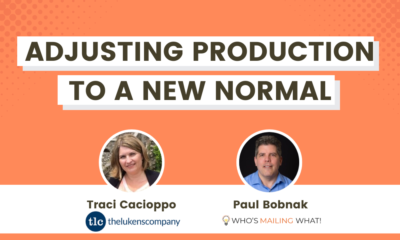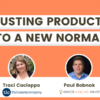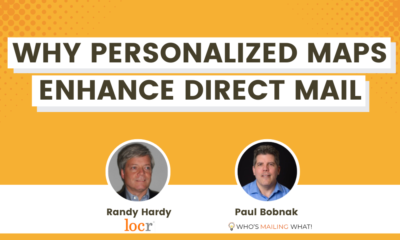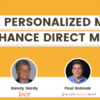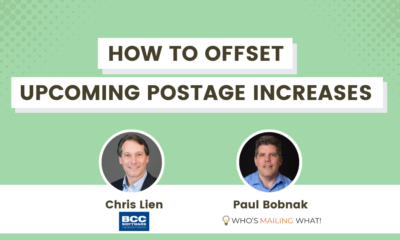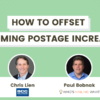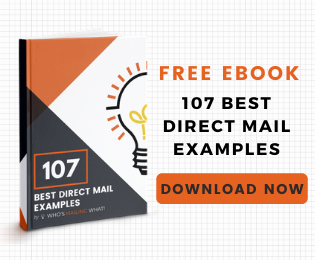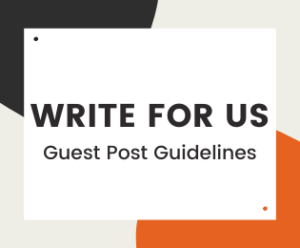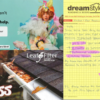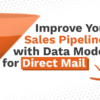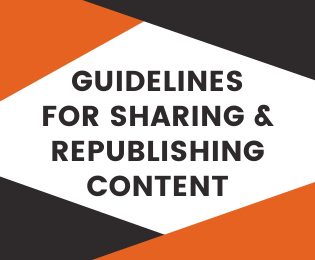MEET THE MAILERS
Meet the Mailers: Digital Intelligence for Print Insights
In this episode, we chatted with CohereOne about how the company has evolved in recent years by helping marketers use print and direct mail to overcome the limits of purely digital marketing.
In this episode, I chatted at length with Tim Curtis, President & CEO of CohereOne. CohereOne is a Bay Area direct-to-consumer marketing agency and strategic consultancy.
We talked a lot about how the company has evolved in recent years by helping marketers use print and direct mail to overcome the limits of purely digital marketing.
As Tim explained:
We utilize very smart, very robust digital technologies to fuel better insights for print.
 Tim CurtisPresident & CEO
Tim CurtisPresident & CEO
CohereOne
Among the many topics we covered:
- His background & day-to-day role
- How CohereOne assesses clients’ needs
- Testing into print
- Role of mail (including catalogs) in retail marketing
- Challenge of data privacy
- Why reading books makes better marketers
- Direct mail’s value proposition today
Here are some questions and answers (edited for clarity and space):
- What type of direct marketing services does CohereOne offer to marketers?
Now it takes on a much more strategic nature. So we are looking at clients’ digital performance, determining lifetime value, helping to measure incrementality on everything we do. We’re not taking a panel and applying that across an industry. We’re doing individual holdouts in that client’s campaigns to determine basically the efficacy of what we’re doing. It could be a catalog format, it could be a direct mail format, it could be a test between the two… helping the client understand long-term what’s the value, where are they going to be growing the business?
[I]t’smuch more forensic nowadays … We do provide the audience development now for all of those services. But it looks a lot different, and the clients are then able to use those audiences and spin them out. We have some clients that will use them in digital campaigns, or they’ll take those best audiences and they’ll use those as lookalike campaigns in the digital space.So it’s much more advanced. And we’ve been doing that effectively for a number of years, and it just continues to fuel our growth. [W]e helped pioneer the development of website visitor information and browse intent, which is then overlaid into circulation campaigns. And it is hugely effective at determining the efficacy of response and indication of response.
So you know, we utilize very smart, very robust digital technologies to fuel better insights for print. No one else does that. And so that history and that testing and that refinement on those has really set us apart. And we continue to utilize new technologies and help in the development of other technologies that push those things along.
[W]hen you understand technology, you understand its limitations and sort of the danger zones where technology may not be perfected yet, and those rushing in to utilize it …, you need to urge caution. So we’re in a much better position to have informed conversations and pushback in areas where we have deep concerns because we have that tech experience. And so we’re not speaking a non-native language when we’re getting into that. And AI is a perfect example.And you offer a marketing assessment to potential clients & customers.
We do. We actually offer some different types. So if a brand is coming in for the first time and wants to try, for example, print … either they’re backed by private equity, venture capitalists, or some combination thereof. And what they’re finding is they’re not punching through in a digital-only, pure-play environment. With the advent of Apple’s intelligent tracking prevention, the tightening of privacy laws … it’s impacted the efficacy of digital and the targeting specifically.
[B]rands are sitting there. They’re being told to hit these growth metrics, and they can’t hit them, utilizing that because they pay more, and the response doesn’t necessarily go up. So, in some cases, they’re paying more and seeing a decline in the efficacy of those ads. Doesn’t mean they’re replacing them completely … but they have to start looking for other ways. [T]hat’s where we’re seeing people getting into testing print and examining print, and then depending on what they’re trying to accomplish, we have a very, very big footprint in the retail space, like the apparel, e-commerce kind of area. We have home goods, home furnishings … and those technologies play quite well in that space. So it’s very effective for us to be able to utilize it and move the needle for clients … that’s why people are having to test into print because they’ve got to fuel that growth. And surprisingly to many of them, they didn’t realize that print was as sophisticated as it is.- What can marketers do better to drive prospects and customers to retail brick-and-mortar locations as well as competing with the Amazons and Targets, etc.?
So where print is shining right now is definitely in the e-commerce space. It is just proven to be so effective at driving online traffic. And the more you understand how to utilize print work in 2023, it’s important to remember that we need to handle print with the care of a physician’s scalpel as opposed to, you know, more of a butcher knife.
Print’s very, very effective. It’s also expensive. And so you have to be careful about the uses of print and how you determine it. However, what we are seeing is that there has been so much of an overreliance on digital, and the digital performance has been so far, below the benchmark than it needs to be for many of these brands post-COVID.
That’s where things have started to get really interesting. Now, as you talk about more of that brick-and-mortar, well, then you’re talking about different formats and different responses that print can drive. Print can be very effective at driving folks to a store for an event. Or it can build … awareness about maybe what’s available in the store.
The challenge that the retail brick-and-mortar side has had is they can get them in, but oftentimes the research shows [that] the inventory has not been there. And so then they’re forced to go back online to either to complete the purchase or wait for the store to order something in on their behalf. So it’s been effective at least doing step one, which is to get some form of an engagement … It’s not been effective in the sense that it can’t cover for what the store experience may bring.
The store experience will still be the primary determination of whether that person completes a purchase or moves on. And so that’s the part that when you’re evaluating brick-and-mortar marketing, and you’re looking at store trade areas, you have to try to understand who’s coming in the door.
And so that’s a little trickier, on the brick-and-mortar side … it’s still effective. You’ll find a lot of, maybe not so much in the retail side, but more of the services side. [Y]ou’ll see … restaurants, quick serve, laundromats …dry cleaners, those kinds of things. You’ll see probably more of the Every Door Direct Mail-type stuff. You know what they’re going to be driving… you still hear a lot of those local businesses talking about the efficiency and effectiveness of those little mailers coming in the front door with them for some kind of, either it’s a freebie or it’s discount offer.
So yeah, the strategies, though, are super interesting to follow.
- I know that the company works a lot with retailers whose traditional channels has been catalogs. I love catalogs but what kinds of things are changing that make catalogs a more relevant channel today?
They can’t seem to break through the attention gap or the engagement gap at a certain level. And the more money they pour in does not mean it’s more of a return, and that’s where they’re finding that edge…Whereas the catalog format for many of those, especially in the apparel, outdoor and home decor categories, for example, it is a virtual showroom. It affords them a better opportunity to position the brand because that’s what’s important. And it’s also, as studies have shown, it’s a much more effective prospecting tool than a solo direct mail piece.
It’s the variety of products. It’s the ability to merchandise the product, all of those things. And so the catalog is not designed for you to call in to a call center or to fill out a form. It’s designed to send you online and complete the purchase, which is a completely different design than historical … It’s just culturally a completely different thing. So it’s almost a showroom or, I hate to use the word lookbook that has a connotation of being thin on strategy, whereas they’re very well thought-through pieces.
They are carefully crafted. For example … in our family of agencies, J. Schmid creative and branding agencies spends their time really creating just incredible design that can be incorporated in direct mail or catalog, and they have a long history as well in the catalog space.
[I]t’s being designed in ways that are beneficial to the brand and the brand-building. And the more you do that, the more attraction you have in terms of the ability to make a sale. For example, you have brands like Yeti, which create a new product, and they sell out quickly because number one, branding – they’ve done. Patagonia is very similar. And so that’s sort of the space we’re in and, and, and how catalogs are different.We work with individual printers on behalf of the clients, or the clients will bring us into those relationships. And so our view of things is usually just a couple of vendors on the list side and a couple of vendors on the printing side, but it’s just completely different.
[T]he consistency that we have today that is completely different than it was 20 years ago is there’s a high high emphasis on brand and branding with these startup companies. [S]o they have a fine attention to that. They’re pouring a lot of money into design and branding. And merchandising. So those are areas that have typically been backwaters in what I would call the catalog space haven’t had as much dollars or attention as they needed to be effective. And so that when you solve for those two, a catalog can be an incredibly effective piece, and then we’ll leverage different smaller direct mail formats in between for different uses, different use cases. [T]hat’s where it really becomes effective, but that is why primarily catalog today has been experiencing the growth we have in there and there is growth. [W]e see it from just the startups. And it’s interesting once they get that taste of “Hey, this actually produces returns”, it’s a quite delightful process after that.- Switching gears, one thing I thought would be interesting to talk about is reading. You posted on LinkedIn that you took some time to find some books at an airport bookshop. What kinds of things do you read, and how does it help you as a marketer and leader?
Well, we follow the EOS model – Entrepreneurial Operating System. And so my role is visionary so that I, in working with them and doing the testing and did that with Gallup as well. And that came back as a very, very strong strength of mine. So I had, for Gallup, for example, in the testing I did with them, it was strategic, futuristic, and ideation very heavily pointed towards, and they indicated that I would be – if I chose to do so – could be a futurist, which I thought was an interesting concept.
[A]ll of that had a basis in one very, very important element of discipline. And that was reading, because reading opened the mind to thoughts and ideas in ways that hadn’t a close second to, [and] that was podcast. The general effect of reading is still considered the top form of learning because there’s a discipline with reading that comes; it’s an active role, whereas podcasting and listening podcasts, and I do a podcast, I know, can be at times passive, it can be going on in the background and won’t necessarily be the same.But I have, for example, seven books right now that I’m going through. And so I will, I kind of shift between them, which probably people are probably thinking “you’re crazy” and maybe I am crazy. But as I look at these titles, it’s important for me to understand the role that book is playing and what I’m trying to address. I’ve got two of them, for example, for marketing artificial intelligence; I’m very, very involved in the AI community.
I have been for a little while and so it’s important for me to keep up with what’s happening. And so these are some books, for example, that were highly recommended that be almost foundational pieces for understanding directionally where you go with AI. And others are designed to stretch my thinking. If you’re not exercising that muscle, then you’re not putting yourself in a position to win.
[O]ne of the things that we do, and I do with my senior leadership team, is we do a book study. [W]e have a book that we’re all working through. And we will spend, I think it’s at least an hour and a half, if not two hours, once a month going over that and it leads to very, very thoughtful, insightful conversations because the book is very carefully curated for that.So, you know, they see the benefit of it culturally. It does a wonderful thing for our company. [I]it’s one thing that people just can’t seem to get enough of when they get here. Like, “man, this is a lot, that’s a lot of fun place to work,” but books have really played a part of that. And books have helped create a sense of community here as well. So yeah, it just goes a long way to helping you shift your mindset.
- So one question I always ask people is: from your viewpoint, what is the best value proposition for direct mail? Why do you think it is relevant and works today?
Well, what I tell people is if you want to marry the best of digital intelligence but marry it to a superior response format, then that’s why you want to go with print.
That always starts a conversation that has never not started a conversation about print, and sometimes it’s the age of the person I’m talking to, or their level of experience, some who are maybe older executives remember a time when catalogs from the early nineties or the late eighties or whatever.
And so they have to have a reset on what print means today, whether that’s a catalog or a solo direct mail piece format or #10 envelope, you know? But that’s how I start those conversations. And that’s essentially what it is. That’s what science is telling us.
So we’re just following the science and having that conversation. And then, we can lay out the results for them. And if they’re, again, kind of going back to your assessment question, if they are a company that’s been doing print, then we’ll offer them a marketing assessment where we’ll go in and take a look, look at all their channel activity, help determine profitability; there are some long-term value questions here if they’re new and have never done it, then we do an opportunity assessment.
What could print do for you? And that’s sort of how those conversations start. It works.
Here is our conversation (with all questions and answers). We’ve added timecodes for your convenience.
Thank you, Tim, for sharing your perspective and your expertise! To learn more about CohereOne, visit their website at www.CohereOne.com.
Your comments and ideas are very important to us in making your Who’s Mailing What! experience even better for you. Through these engaging talks, we hope you’ll take away practical tips, insights, and personal stories to inspire and build your own success.
If you have any feedback — or are interested in sharing your expertise and viewpoint with our wide and diverse audience on “Meet the Mailers” — please reach out to me. I’d love to hear from you!









